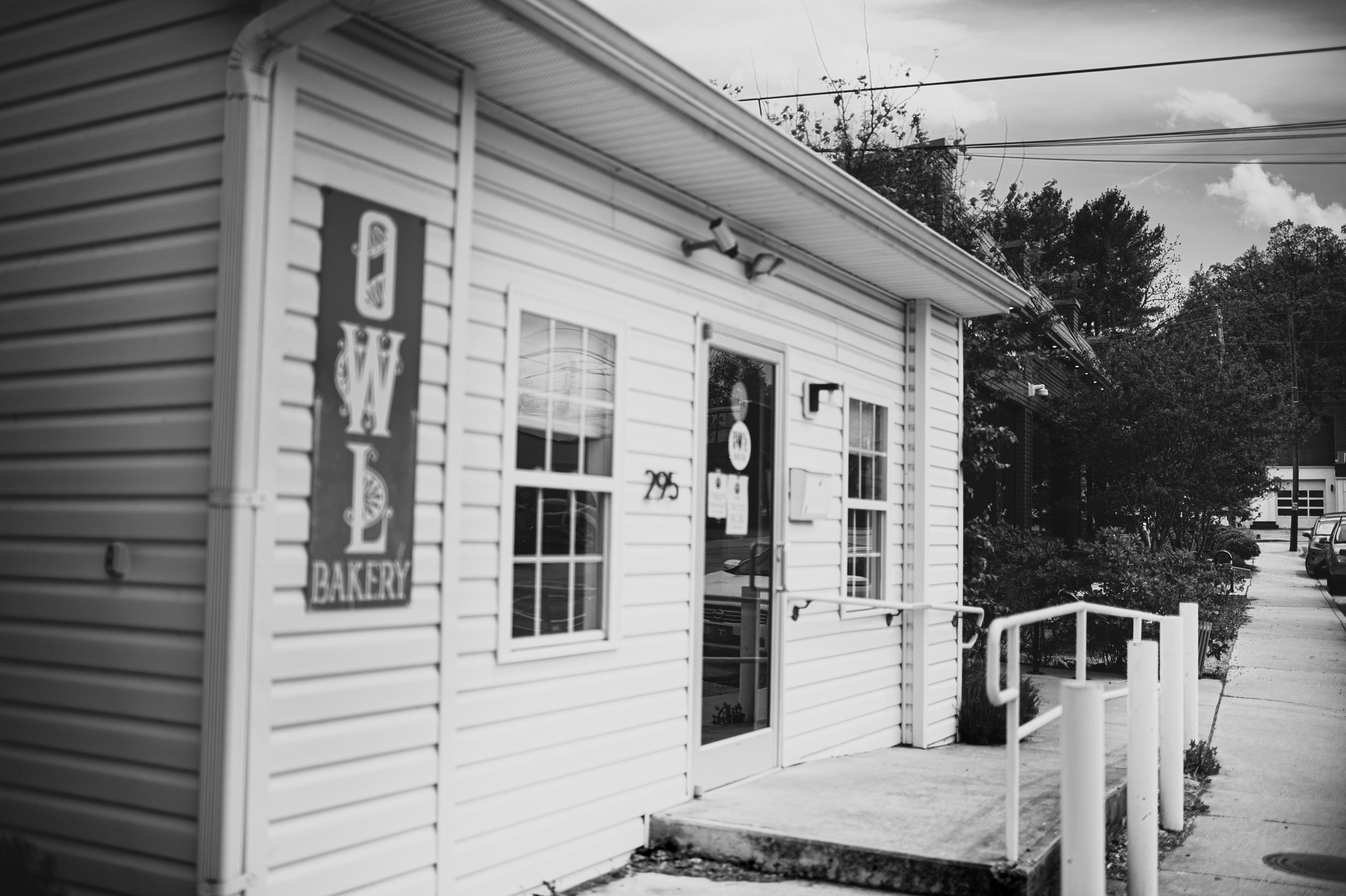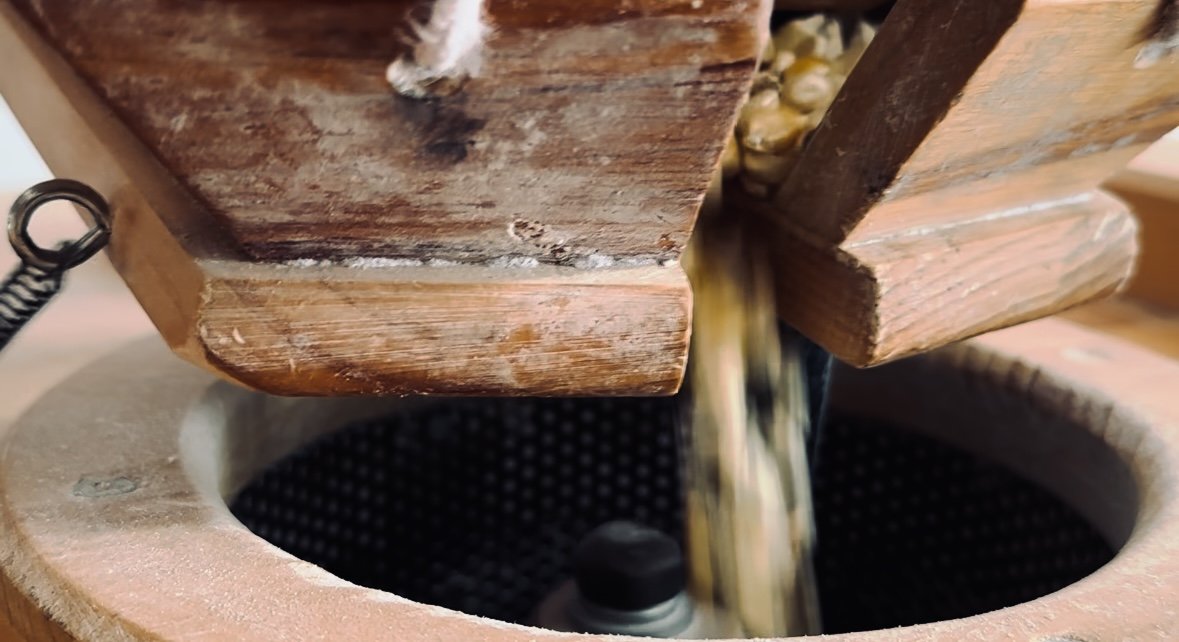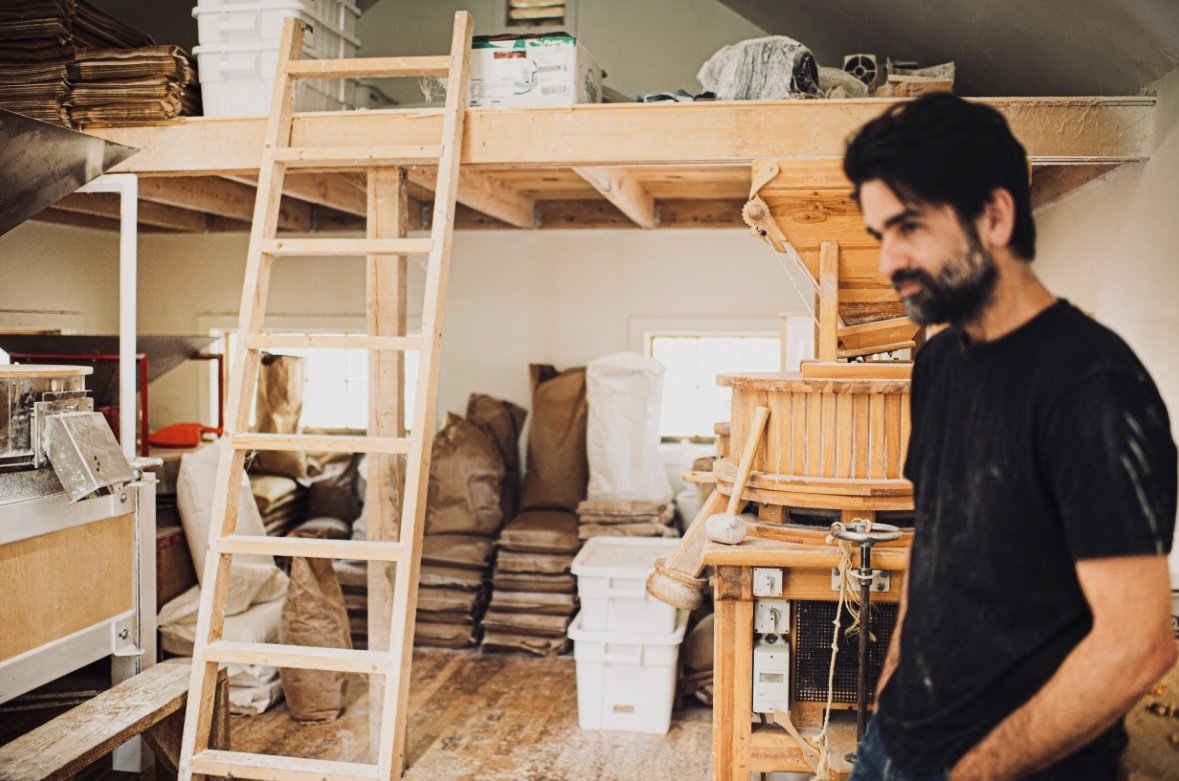FARM AND SPARROW
A VISIT TO ASHEVILLE, NORTH CAROLINA
* * * * * * * * * * * * * * * * * * * * * * * * * * * * *
* * * * * * * * * * * * * * * * * * * * * * * * * * * * *
THE ANTIDOTE
Farm and Sparrow: A MILL VISIT WITH DAVID BAUER: OUTSIDE OF ASHEVILLE, north carolina
So many trees and I wonder if they scare me. I come from more of a desert I suppose. We can see for long distances from the tips of the chaparral mountains to the islands at sea. Our brush is low and we have cactus and rattlesnakes among our citrus blossoms and oaks. So the lines of tall green trees whipping by us on the North Carolina highway give me a feeling of unease at first. Things feel thick like heavy clouds do when they fill up with rain.
The best western is motel not hotel with no elevator to lug the big bag up to the second floor. It’s a heave ho and we topple our bodies, boots and all, on top the thin bed sheets. Seconds flat and we are on the road again, backtracking the thirty minutes to Tryon and a mega center of equestrian fanfare. It is the Nationals and Frances is competing. It feels like a long weekend ahead so I put my head down and do whatever a mother is supposed to do.
Lately, I plan my work around the unknown. It’s rather spontaneous. When I heard we were on our way to North Carolina at the end of April my mind went directly to bread. “Who bakes bread in the south?” “If I plan accordingly, what can I learn?” I had a couple people in mind I wanted to meet so I reached out to a woman who I’ve followed for some time. She has made a name for herself in the bread world via workshops, and bread baking books. Her knowledge of the craft is part science, part art, but even more aptly she seems to connect the dots within our community of bakers. Tara Jensen started as “Smoke Signals" but now goes by “Bakershands” and lives somewhere in the farming community of Virginia, I believe. She kindly reached out to her Asheville friends and made an introduction. “Hi Jen, Hi Dave. This is Kate. Kate, meet Jen and David”. Emails exchanged.
I think to get the most out of this story I have to back track a bit. Back to when I lived with a farmer. Back to when we baked bread outside in an oven he built with eucalyptus branches, mud and stone. Peter would bake straight whole wheat bread that could stop a door neat and tight. It was dense like a brick. He gave away loaves with a smile saying he used local honey and baked it with fire.
Peter interned at a biodynamic farm in Covelo where he learned to farm, up in Northern California. Live Power Farm was run off of horse drawn plows and the compost was stirred in the direction of the stars drawing in the energy of the cosmos. Rudolf Steiner farm philosophies, “spiritual science”. Peter studied the farm practices of Alan Chadwick, Elliot Coleman and others as he pursued farming within a community of out of the box thinkers and organic revolutionaries. Small scale farming, organic practices, sustainability were the name of the game.
Along the same lines was another movement happening within the world of bread. Individuals exploring the smaller scale, natural methods of old school artisanal baking. All baked in a wood fired oven. The creme of the wood fired oven crop was a man named Alan Scott, an oven builder from Tasmania. He was making his bread oven workshop rounds through farms, folk art schools and small bakeries throughout the US. One such project took him to Live Power Farm.
Upon Peter’s return home and the building of his small garden farm on his father’s property, he embarked on building an oven of his own with the help of his friend Jennifer Greene, another farmer from up north who found comfort in the work of Norwegian fjord field horses to plow her fields of wheat and eventually corn, which became the mainstay grain which she milled for small scale production of tortillas.
When I came into the picture, his oven was done, he was running a small Community Supported Agriculture program (CSA), baking his brick hard whole wheat bread and had a flock of chickens that ran free in the upper field around his mobile chicken coop that looked like small wooden outhouse on wheels. I stumbled across Alan Scott on the bookshelves in Peter’s house flanked by his father’s books on Darwin, marine biology, Chumash history and decorative diagrams of the kama sutra. On the front cover of Alan’s Oven Builders book was a very young Chad Robertson pulling rustic loaves from the hearth of a brick oven.
By the time Frances was nearly two we had grown some wheat. Two, hundred foot rows of a hard red that we harvested with a scythe, dried in bunches leaning up against the house in the driveway. Frances and I stomped around on the dried stalks to break away the wheat kernels and then winnowed it with a fan outback by the oven. We milled it with a crank mill that we shimmied onto the railing and clamped shut. Twelve cups of flour. That was it. Two large loaves of whole wheat bread. Seed to loaf and baked by fire.
My foray into wheat growing was short lived but my curiosity had me scoring books and articles on small scale wheat growing and milling. One such article was about a North Carolina woman who had set up a millshop with a mill from the late Alan Scott after his passing. Her name was Jennifer Lapidus and she ran Carolina Ground.
So, back to last week and I found myself in a motel room ten minutes from Jennifer’s Flat Rock mill outside Hendersonville North Carolina. We tried to connect but family obligations had her busy, so instead she offered up some recommendations of bakeries in the area. OWL Bakery and a walk through the Saturday tailgate market in Asheville. It was a lovely morning introduction to the area before Frances and I headed even further up the mountain to another miller whose daily plans left room for a visit and tour of his small boutique milling process.
We pulled up a dirt driveway along the fence line of an old white clapboard Chapel. It’s pitched roof and steeple crept out from the trees, although I noticed that the trees did not seem as thick as the lower half of the blue ridge mountains near Tryon. Unbeknownst to me, we had climbed a bit on the drive, a steady meandering hill that opened to more farm like fields instead of forest. The first thing Dave asked as he walked out through the gate was “So, did you feel the mountains?” It didn’t really dawn on me until he said it. Our mountains are different. Rugged and big as of the west. His mountains were old rolling hills green and lush. At that moment the trees didn’t scare me as much. He walked me into his shed mill shop and we started talking.
Farm and Sparrow is run by miller/baker David Bauer. His story is a good one. His story is the antidote to what is ailing our industry. It is a recollection of bread and milling before the masses got their long acrylic fingernails into bread dough and mass master classes on the quick media platform of social media. Everyone teaches sourdough now. All experts since lockdown and Dave’s wife wonders if he has anything worth teaching now that everyone can teach you how to feed a starter, fill a mixer, and stitch those pillowy sourdough loaves together before dutch ovening the crap out of them. “When did every loaf of bread need an open crumb?” “Why do the French now make bread like Tartine instead of their traditional techniques?” Dave remembers visiting Tartine in San Fransisco after it first opened, long before “the bread book”. He said Chad’s loaves were made with stone ground flour. “It wasn’t golden light. It was kind of grey and spongy in the middle. It was wild”.
Dave met Alan Scott in his twenties. He worked with him for five years building bread ovens during Alan’s many workshops. Bread was the next logical step so Dave found himself at the doors or Dave Miller’s shop in Northern California. For one day only he worked along side Miller shaping and baking off six hundred loaves of bread. With a quiet and calm demeanor he found Miller to be a Buddha of sorts, breaking only for a lunchtime apple each and onto more shaping. Although Miller was a game changer, Dave, instead, took a job working for The French Laundry. He stood in a window filling tiny bread baskets to the brim with miniature French bread varieties shaped with tooth pick rolling pins.
Over the next couple of years his time was shared with Alan during oven projects and soon, through Alan, Dave was introduced to Jennifer Lapidus. She was seeking someone to take over her baking operation after her burnout of too much baking and single motherhood. He could bake out of her space in Asheville and sell at her stand at the Wednesday farmers market. She was moving into milling.
He grew his baking into a bakery operation and soon a restaurant but to his dismay, (as seems to be the running theme here for most of us bakers), he too burnt out. The commitment to a struggling business with long hours and no happiness return left him discouraged and discontent. He closed shop and he too, found his way into milling.
We talked corn. We talked a lot about corn. If you were to name the most traditional bread of the Blue Ridge Mountain region it would be corn bread. The most traditional grain would be grits. Dave’s interest lies in the land and the farmers. The history and tradition of the area he now calls home. His mission is to work with farmers and landrace crops to propagate stronger and more evolutionary diverse and resilient grains. To evolve an ancient lineage of corn so that it survives in numerous regions and climates and bares a texture and flavor that holds it’s own without the additives of creams and spices in chef’s high end kitchens. He shows me his corn. The creamy white Tuxpeno, an ancient Mexican variety, he started with. Then on to the yellow variety. From there they selected only kernels with variations of red to cultivate a red Tuxpeno. It’s red resembles the bloody butcher corn but tipped with yellow, a stunner.
Dave hopes to encourage people to incorporate more milled corn into their breads. To diverge from the crowd and get creative and experimental again with baking. He recently posted a loaf of sourdough he made using a higher percentage of milled corn to wheat. It had a more closed crumb, soft not dense. It looked beautiful and fresh. It also looked old, like something you would have found in bakeshops of yore. In the underground world of bread. Where people baked out of curiosity for good flavor and dark crusts and didn’t shy away from a loaf of another color.
Dave has so much to offer a community and industry of bakers. I hope he finds a way to teach. His value is in his deep experience over years of commitment in this field of work. He did not go large scale. He did not go into production baking. His path was craft and commitment to the artisanal skills of baking and milling. His path is community based not mass marketing. He has stayed true to the philosophies of the old farmers and oven builder who believed “commerce should always be tied to morality and always be tied to beauty and art”. We should all be so wise to listen and learn.
I would have liked to have stayed longer. To explore the area. To have had a meal. I would have liked to have met Jennifer to make the story full circle but that is for another time. I am grateful for the generosity of our bread folk and the stories they tell. Like I said above, the time and exploration into these stories and memories are the antidote I’m looking for. They will reset what has gone so awry and give substance to our skill set as bakers and creators in food and community life. People have to be willing to let go of the formula, to think for themselves and have the guts to be different.
Frances won the Nationals on a little horse named Bandit. We flew home on Monday. I talked to a man on the plane ride home. People call him Circus.. He was born into it and ran away at 18 to join the navy. His father was the lion tamer with a thick Hungarian accent and rode the horses acrobat style too. Navy seals to government contracting, to deputy sheriff duties all about. Making mescal in the Oaxacan agave fields….making legit business of old bootlegging spirits from Oaxaca to Mexico City. He has an old veteran friend Gary who shoots crows off people’s trucks from his fifth wheeler, straight through the screen door. Good stories from a stranger as my daughter watched Forrest Gump on the airplane seat in front of her. I thought how ironic that I had my own Forrest right next to me telling me “long stories short”. He’s going to be a “spirits man”. For his final show. I was thankful for Circus and his kindness on our flight. I was thankful for his humor and good story telling. And the photos of his father with the lions and tigers and bears. Strangers give you valuable perspective and remind you that we are all in the same boat to some degree.
Connection and reconnection is going to set things straight again. I have faith in that. I have faith in corn now as well. If it can survive the hurricane then maybe we can too!
* * * * * * * * * * * * * * * * * * * * * * * * * * * * *
* * * * * * * * * * * * * * * * * * * * * * * * * * * * *
FARM AND SPARROW
A SHORT FILM
A NORTH CAROLINA MILL VISIT WITH DAVID BAUER



















